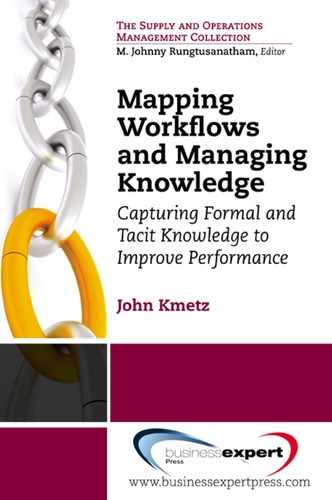How to Use This Book
This book has been written primarily as a how-to guide to Workflow Mapping and Analysis, and is focused on mapping organizational processes. At the same time, it explains why we need to do certain things, and provides some thinking tools to help achieve that.
As we will see in chapter 2, “processes” are combinations of actions and information. To really understand a process and map it, you have to understand both of these parts. The actions, and the material we work on (often information itself), are the easy parts to capture. Information is trickier—the formal part is the information we can see in rules, procedures, policies, and the like, and that is usually pretty visible. But people do things in different ways, for many reasons, and so the really hard part is capturing this “tacit” knowledge, which gets built into how everyone does his or her part of a process. If a company or organization wants to understand its processes, and perhaps set up a knowledge management system at some point, it will have to include this tacit knowledge.
For the person who needs to get a handle on processes right now, the place to start is chapter 3—this is the core chapter on process mapping. Chapter 4 then helps figure out how to collect data on a workflow from the maps we create, and analyze and interpret it to do things like process improvement and change. A great deal depends on intelligent use of our eyes, but a spreadsheet helps. Simplicity is the key to both making and analyzing the maps.
At some point, the user ought to back up and read chapter 2 to have a fuller understanding of organizations as “systems,” which they all are, and of processes within them. Finally, since information is fundamental to everything we are trying to do, the user should take some time to read chapter 1. Doing what chapters 3 and 4 show from the perspective of the first two chapters will make for better workflow maps and the applications users put them to later. In comparison with chapter 3, chapters 1 and 2 may seem somewhat academic, but those chapters provide thinking tools that are as important as the mapping tools, and they work better together; if you have time, start with chapters 1 and 2— both are short.
Chapters 5 and 6 extend our capabilities in two useful directions. If we want to get into more far-reaching knowledge-management efforts, chapter 5 gives some insight into that and helps shape expectations for what we can and cannot do with it. Chapter 6 gives us a preview of the next level of mapping, which is to use it as a precursor for dynamic simulation of our organizational processes. There is already a lot of this kind of simulation being done, and I believe it will become a source of competitive advantage for many firms in the future.
Can we actually do workflow mapping without software, as I suggest many times in this book? To draw the maps, we really don’t need anything more than the drawing programs that are built into word processors and spreadsheets, but a dedicated program like SmartDraw or Visio (among others) can be very helpful. For data analysis, you need a standard spreadsheet. What you don’t need is a costly, complex, proprietary process mapping program (and often all the support staff that comes with it).
